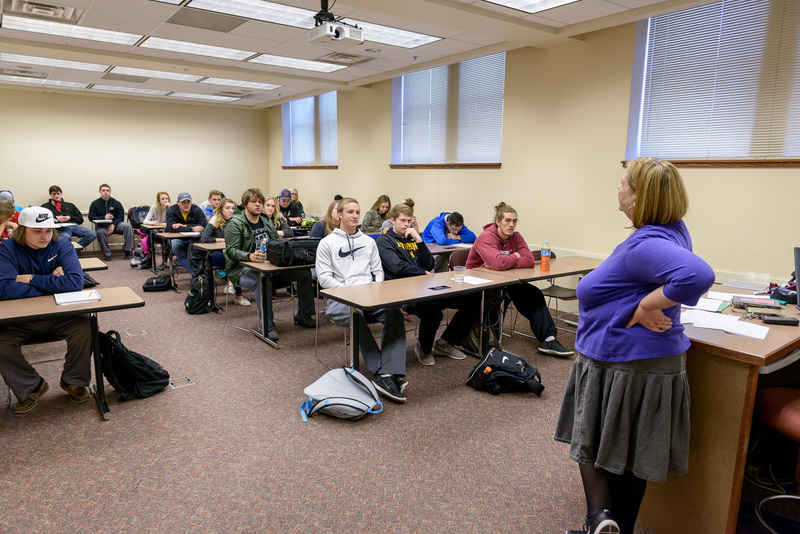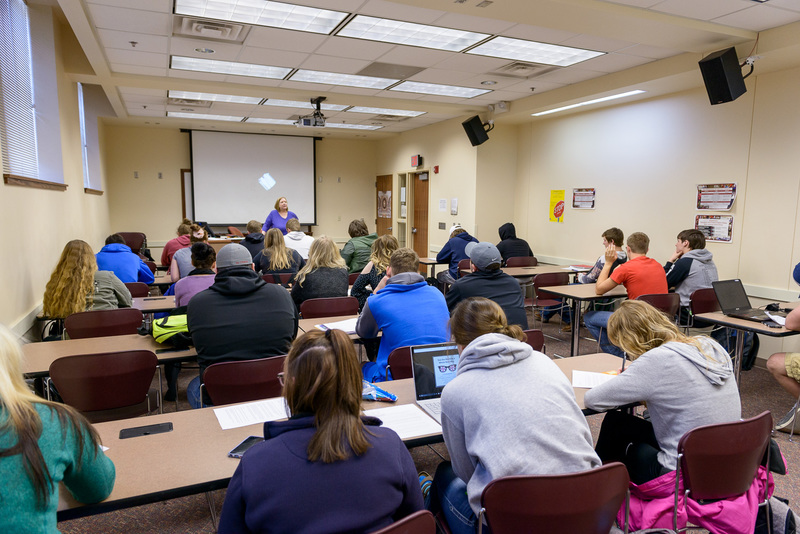Pop culture lives!

CHADRON – There’s a reason course titles such as Zombiepocalypse and Gaze Anatomy sound like they’re more at home on television or movie screens than in the classrooms at Chadron State College. Episodes dealing with zombies or hospital dramas entertain viewers, however, according to Communication and Social Sciences Assistant Professor Dr. Janice Haynes, pop culture flashpoints can also be effective tools to lead students to think critically during First Year Inquiry (FYI) classes.
“We want students to think deeply about a topic and multiple ways on how to look at that topic,” said Haynes, who studied at the University of Houston before earning her Ph.D. from Massachusetts at Amherst. “These discussions based around pop culture are a way we can get students to get really interested and engage them in a topic, but to also teach them to do critical inquiry.”
Chadron State students must complete six hours of FYI courses, but they are not discipline specific. Rather, the courses focus on critical thinking and gaining a deeper understanding of particular issues or problems.
Haynes, who also teaches students how to be good citizens on social media and respond appropriately to criticism or disagreements in Constructing Digital Citzens (CA 336), said she is able to use pop culture and media to help students explore different ways of thinking.
“Any form of media is good to address questions because there’s not always one solution or one way to look at something,” she said. “I can watch any film and have a reaction that is different from anyone else. A lot of how we experience media has to do with our own experiences, based on our gender, race, sexuality and other defining characteristics. Then, if we add rigor and interpretative analysis, students will use research to interpret what is happening and how that relates to culture and society.”
Haynes, a self-professed fan of zombie films, said pop culture has the ability to reflect current social anxieties. That idea is explored in depth during her class Zombiepocalypse (FYI 169AM) this spring. She said zombies are a metaphor for people who are seen as unordinary.
“If we look at post Sept. 11, there’s an explosion of zombie films and apocalyptic and post-apocalyptic films. In the context of the last 10 years, there’s been even more due to the wars in the Middle East and the financial crisis,” she said. “Now, all these fears and social anxieties are being translated into our pop culture. FYI courses are about teaching students how to ask questions through an interdisciplinary approach, how to research, think critically and work collaboratively. So if you have something that students are interested in like zombies, it is a little easier to engage students and teach critical inquiry.”
Haynes teaches students that zombies can become a metaphor for a variety of social groups, including slaves, immigrants, and outcasts, and even represent the collective loss of humanity. The class also discusses what viral outbreaks can symbolize and report on critical writing.
“The origination of zombies came from voodoo and that began in the 1930s when ‘White Zombie’ was released at the same time the U.S. invaded Haiti. They’re not flesh eating zombies in the movie, they have spells cast upon them that turn them into slaves. So Haiti was the first colonial nation to have a successful rebellion,” Haynes said. “If you think about it, if colonizers turn people into slaves then the representation of slave labor and the reinforcement of colonialism shows how people become mindless workers.”
Another media literacy course taught through the lens of pop culture is Gaze Anatomy (FYI 169AN).
Haynes said the class, offered again in Fall 2017, will teach students how they’re influenced by pop culture. One way to do that is studying psychoanalytic theory. Haynes said the class will watch Alfred Hitchcock’s film “Rear Window,” and compare it with Maggie Greenwald’s “The Ballad of Little Jo.” “Rear Window” deals with a male protagonist voyeuristically observing his neighbors through a window, while “The Ballad of Little Jo” is a true account of a woman who travels West to avoid persecution for having a child out of wedlock. The female protagonist lives disguised as a man and eventually falls in love with another man.
“The idea of the gaze is complicated. It is not just about gender, it’s about so many other things and they can all be different,” Haynes said. “We look at that through the lens of large structures of race, class, gender and sexuality. We talk extensively how media plays a role in influencing how we think about things.”
Haynes said the class also watches television series and discusses critical readings related to forms of media.
“We watch television series such as ‘The Simpsons,’ ‘Family Guy,’ and ‘Sex and the City,’ and compare them to older shows or characters such as Archie Bunker,” she said. “We also look to advertisements for symbiotic analysis.”
One thing not up for analysis are the names of the FYIs. Haynes said the catchy names describe the courses and pique interests of students.
“The courses are named the way they are to attract students,” she said. “We want them to sound interesting because students are required to take FYIs. But the names of the courses don’t indicate the rigor of the courses. You can look at any subject through pop culture and we do that in an academic way.”
Category: Campus News, Social Sciences

